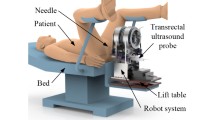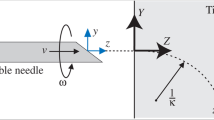Abstract
Purpose
Surgical robots have multiple manipulators with complex mechanisms and need to work in a narrow space in the patient’s body. Therefore, for robot-assisted minimally invasive surgery (RMIS), it is very important to develop a reasonable preoperative planning before surgery.
Methods
A preoperative planning method based on the premise of no collision between surgical instruments and endoscope, an evaluation index with visibility, operability and hand–eye coordination was proposed in this paper. To consider the balance relationship of global optimization index, a multi-objective particle swarm optimization (MOPSO) algorithm was adopted. Because the physical characteristics of each patient are different, the method can determine the selectable area of the incision based on the relevant knowledge of anatomy.
Results
The simulation taking the cholecystectomy as an example was performed on a minimally invasive surgical robotic system. The analysis result showed that the proposed preoperative planning method based on the MOPSO could provide surgeons with a reasonable and effective preoperative planning.
Conclusions
The proposed preoperative planning method based on the MOPSO is suitable for patients with different physical characteristics, and can provide a guidance for surgeons and effectively reduce the preoperative planning time and improve the safety and efficiency of the operation, especially a novice surgeon who lacks robot-assisted minimally invasive surgery experience.















Similar content being viewed by others
References
Miyamoto S, Sugiura M, Watanabe S, Oyama K (2003) Development of minimally invasive surgery systems. Hitachi Rev 52:189–195
Peters BS, Armijo PR, Krause C, Choudhury SA, Oleynikov D (2018) Review of emerging surgical robotic technology. Surg Endosc 32:1636–1655
Vitiello V, Lee SL, Cundy TP, Yang GZ (2013) Emerging robotic platforms for minimally invasive surgery. IEEE Rev Biomed 6:111–126
Robinson TN, Stiegmann GV (2004) Minimally invasive surgery. J Endosc 36(1):48–51
Adhami L, Coste-Maniere E (2003) Optimal planning for minimally invasive surgical robots. IEEE Trans Robot Automat 19(5):854–863
Trejos AL, Patel RV, Ross I, Kiaii B (2007) Optimizing port placement for robot-assisted minimally invasive cardiac surgery. Int J Med Robot Comput Assist Surg 3(4):355–364
Zhang F, Yan Z, Du Z (2016) Preoperative setup planning for robotic surgery based on a simulation platform and Gaussian process. In: IEEE International Conference on Mechatronics and Automation; August 7–10; Harbin, China, 902–907
Nguyen QC, Kim Y, Park S, Kwon HD (2016) End-effector path planning and collision avoidance for robot-assisted surgery. Int J Precis Eng Man 17(12):1703–1709
Trejos AL, Patel RV (2005) Port placement for endoscopic cardiac surgery based on robot dexterity optimization. In: International Conference on Robotics and Automation (ICRA); April; Barcelona, Spain, 912–917
Badani KK, Muhletaler F, Fumo M, Kaul S, Peabody JO, Bhandari M, Menon M (2008) Optimizing robotic renal surgery: the lateral camera port placement technique and current results. J Endourol 22(3):507–510
Austad A, Elle OJ, Rotnes JS (2001) Computer-aid planning of trocar placement and robot setting in robot-assisted surgery. Int Congr Series 1230:1020–1026
Ferzli GS, Fingerhut A (2004) Trocar placement for laparoscopic abdominal procedures: a simple standardized method. J Am Coll Surg 198:163–173
Hayashibe M, Suzuki N, Hashizume M, Kakeji Y, Konishi K, Suzuki S, Hattori A (2005) Preoperative planning system for surgical robotics setup with kinematics and haptics. Int J Med Robot Comput Assist Surg 1(2):76–85
Liu D, Li J, He C, Kong K (2011) Workspace analysis based port placement planning in robotic-assisted cholecystectomy. Proc Int Symposium IT Med Educ 1:616–620
Cannon JW, Stoll JA, Sellha SD, Dupont PE, Howe RD, Torchiana DF (2003) Port placement planning in robot-assisted coronary artery bypass. IEEE Trans Robot Automat 19(5):912–917
Zhang F, Yan Z, Du Z (2017) Preoperative planning for the multi-arm surgical robot using PSO-GP-based performance optimization. In: IEEE International Conference on Robotics and Automation (ICRA), Singapore, 4208–4214
Feng M, Jin X, Tong W, Guo X, Zhao J, Fu Y (2017) Pose optimization and incision placement for robot-assisted minimally invasive surgery in cholecystectomy. Int J Med Robot Comput Assist Surg 13(4):1–9
Adhami L, Coste-Maniere E (2002) A versatile system for computer integrated mini-invasive robotic surgery. Lecture Notes In Computer Science, Proceedings of the 5th International Conference on Medical Image Computing and Computer-Assisted Intervention, 2488: 272–281
Du Z, Wang W, Wang W, Dong W (2017) Preoperative planning for a multi-arm robot-assisted minimally invasive surgery system. SIMULATION 93(10):853–867
Wang W, Du C, Wang W, Du Z (2019) A pso-optimized fuzzy reinforcement learning method for making the minimally invasive surgical arm cleverer. IEEE Acess 4(22):48655–48670
Sun LW, Van Meer F, Schmid J, Bailly Y, Thakre AA, Yeung CK (2007) Advanced da Vinci surgical system simulator for surgeon training and operation planning. Int J Med Robot Comput Assist Surg 3(3):245–251
Hayashibe M, Suzuki N, Hashizume M, Konishi K, Hattori A (2006) Robotic surgery setup simulation with the integration of inverse-kinematics computation and medical imaging. Comput Meth Prog Biomed 83(1):63–72
Azimian H, Patel RV, Naish MD, Kiaii B (2013) A semi-infinite programming approach to preoperative planning of robotic cardiac surgery under geometric uncertainty. IEEE J Biomed Health Inf 17(1):172–182
Luo XC, Wang ZR (2009) Human Anatomy. World Publishing Corporation, Beijing, China
Gao Y, Wang S, Li J, Li A, Liu H, Xing Y (2017) Modeling and evaluation of hand-eye coordination of surgical robotic system on task performance. Int J Med Robot Comput Assist Surg 13(4):1–9
Selha S, Dupont P, Howe R, Torchiana D (2002) Dexterity optimization by port placement in robot-assisted minimally invasive surgery. In: Intel systems and advanced manufacturing 4570: 97–104
Hanna GB, Shimi S, Cuschieri A (1997) Optimal port locations for endoscopic intracorporeal knotting. Surg Endosc 11:397–401
Manasnayakorn S, Curschieri A, Hanna GB (2008) Ideal manipulation angle and instrument length in hand-assisted laparoscopic surgery. Surg Endosc 22(4):924–929
Rosen J, Brown J, Chang L, Barreca M, Hannaford B (2002) The BlueDRAGON-A system for measuring the kinematics and the dynamics of minimally invasive surgical tools in-vivo. Proceedings 2002 IEEE/ICRA; Washington, DC, USA, 1876–1881
Acknowledgements
This research is supported by the National Natural Science Foundation of China (NSFC) (Grant No. 51975409).
Author information
Authors and Affiliations
Corresponding author
Ethics declarations
Conflict of interest
The remaining authors declare that they have no conflict of interest.
Human and animals rights
This article does not contain any studies with human participants or animals performed by any of the authors.
Informed consent
This article does not contain patient data.
Additional information
Publisher's Note
Springer Nature remains neutral with regard to jurisdictional claims in published maps and institutional affiliations.
Rights and permissions
About this article
Cite this article
Yang, Y., Han, S., Sang, H. et al. Preoperative planning method based on a MOPSO algorithm for robot-assisted cholecystectomy. Int J CARS 17, 731–744 (2022). https://doi.org/10.1007/s11548-021-02547-2
Received:
Accepted:
Published:
Issue Date:
DOI: https://doi.org/10.1007/s11548-021-02547-2




